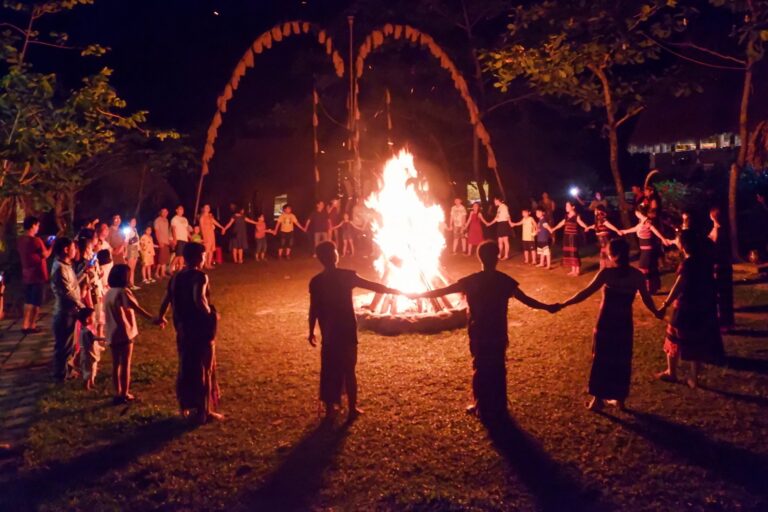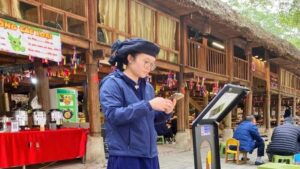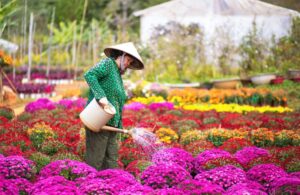The Management Board of Bac Huong Hoa Nature Reserve, Quang Tri Province, unexpectedly discovered an individual of the Asiatic black bear (scientific name Ursus thibetanus) weighing about 150 kg, living in the reserve through a digital camera trap.
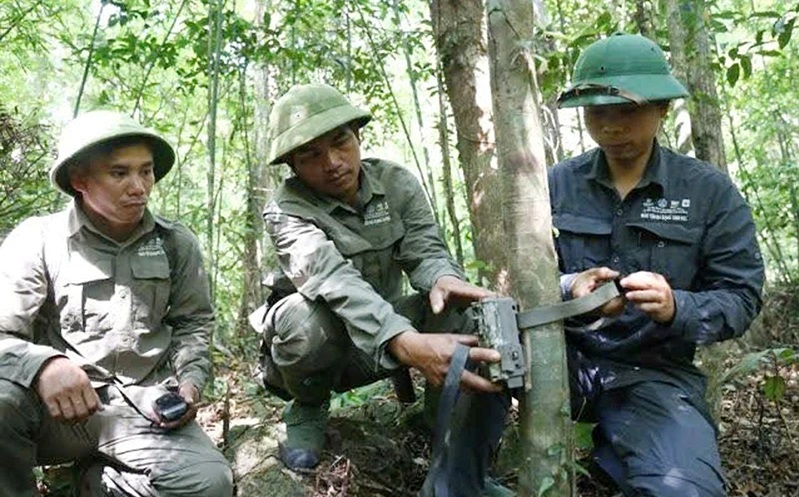
Staff of Bac Huong Hoa Nature Reserve set up camera traps to track the traces of Asian black bears. (Photo: Bac Huong Hoa Nature Reserve)
This discovery attracted the attention of the public and many scientists to find sustainable solutions to conserve rare and endangered bears.
Bac Huong Hoa Nature Reserve is home to a unique forest ecosystem, growing on limestone mountains, with a mixed structure of bamboo with broadleaf and coniferous trees, a diverse flora, creating biodiversity, with species conservation value in Vietnam and internationally. With that special nature, Bac Huong Hoa Nature Reserve is home to many rare and precious wild animals.
Setting up camera traps
According to the International Union for Conservation of Nature, the bear is listed as an endangered species. In Vietnam, this species is regulated in Appendix I, the list of endangered, rare species prioritised for protection according to Decree 160/2013/ND-CP and amended by Decree 64/2019/ND-CP.
Ha Van Hoan, Director of the Management Board of Bac Huong Hoa Nature Reserve, said: Within the framework of the project "Rescuing Saola from the brink of extinction", the International Union for Conservation of Nature in Vietnam, project partners and units have conducted a survey of Saola in areas with the highest potential for survival using camera traps and collecting environmental DNA samples (leech samples and stream water samples) from August 2023 to June 2024.
The survey team has worked hard to overcome difficult and complex terrain and harsh weather to complete the installation of 385 camera traps, each camera set up in the forest for at least two months. However, before any traces of the saola were recorded, the survey team recorded surprising results, images of the activity of the Asiatic black bear in the reserve. Ha Van Hoan recalled that at that time, the team was extremely happy, that the discovery of the Asiatic black bear, opened a new page in the protection of this rare and endangered animal species.
The discovered Asiatic black bear is estimated to weigh about 150 kg, and is very active. This is an animal that can protect itself to survive in the wild and is quite sensitive to nature, so it is very difficult to camera trap. Currently, the management board has not discovered any more Asiatic black bears, and it is also not possible to determine the population of this bear species in the area.
However, according to many sources of information from local people, sometimes while going to the fields, they accidentally discover smaller bears. Ha Van Hoan added that in addition to Quang Tri, bears have been discovered in other localities of Vietnam, such as Quang Nam Province in 2014 and Thanh Hoa Province in 2024. The appearance of this species in natural forest areas is remarkable, so conservation work needs to be carried out immediately.
The appearance of bears in Bac Huong Hoa Nature Reserve is an important indicator, showing that the quality of primary forests, and the habitat of rare and endangered animals is still maintained stably and forest management and protection activities are being effective. This discovery also helps the management board of the reserve and scientists have more information to better protect bears; providing important data for the orientation of future scientific research.
The distribution range of the Asian black bear in Quang Tri Province is determined to be within the Huong Hoa-Da Krong biodiversity corridor, including the Bac Huong Hoa Nature Reserve.
This is a relatively safe area for existing wild species to live, ensuring survival and development. However, the biggest threat is the risk of forest encroachment from hunting, trapping wild animals and illegal exploitation of forest products. Along with that is the noise impact from the construction of infrastructure works, hydropower plants, and road construction, affecting the lives of this species as well as other wild animals.
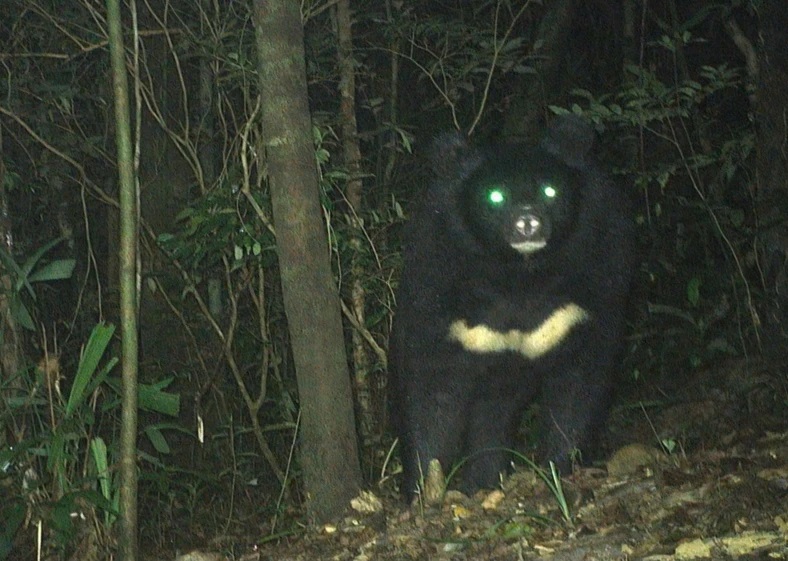
An Asian black bear was discovered in the Bac Huong Hoa Nature Reserve by a camera trap. (Photo: Bac Huong Hoa Nature Reserve)
Safe environment for rare animals
Over the years, the Bac Huong Hoa Nature Reserve Management Board has made efforts to protect forest resources despite facing many difficulties such as limited forces and a large area. The protection efforts have achieved results, creating a safe environment for the survival of many endangered and rare animal species.
According to Ha Van Hoan, immediately after discovering the individual Asian black bear, the unit had many urgent solutions to protect it such as increasing coordination in patrolling, removing traps in the forest, propagating and mobilising people not to trap and catch Asian black bears, building a forest protection network in villages.
Coordinate with the International Organisation for Conservation of Nature in Vietnam to mobilise resources and provide technical support to continue investigating biodiversity to have more scientific data, from which to build a species conservation plan in the coming time. Survey and monitor the existing Asian black bear population through camera traps; track traces and collect biological samples to determine the quantity, distribution, and health status of the Asian black bear population in the area.
However, the long-term solution requires cooperation with non-governmental organisations to mobilise resources for conservation and research, as well as sharing experiences, knowledge and resources in bear conservation.
It is necessary to develop sustainable livelihoods for local communities in the area through support for seedlings, breeds, forest protection contracts, and support for developing agroforestry models, and environmentally friendly economic models to reduce people's dependence on forests.
At the same time, functional forces need to strengthen law enforcement, prevent illegal hunting, improve the capacity of conservation area staff, and apply data management tools and patrol reports in monitoring patrols.
Also in this reserve, through previous years’ surveys, the management board recorded many wild animals living there such as gaur, striped rabbit, white eared, red-throated partridge, rufous-cheeked laughingthrush, pangolin, serow, Siki gibbon, Hatinh langur, red-shanked douc langur, loris, red-faced monkey, pig-tailed monkey, wild cat.
Acting Chairman of the People's Committee of Quang Tri province Ha Sy Dong said: To have a sustainable solution to protect the Asian black bear, the province directed the Management Board of Bac Huong Hoa Nature Reserve to coordinate with agencies and scientific units to advise the Department of Agriculture and Environment to develop an action program to conserve the Asian black bear species to submit to the People's Committee of Quang Tri Province to issue the action program.
Strive to develop the above conservation area into a national park by 2030 according to Decision No. 895/QD-CP dated August 24, 2024, on approving the National Forestry Planning for 2021-2030, with a vision to 2050 of the Prime Minister.
If this is done, it will be an opportunity to conserve the Asian black bear and other endangered wildlife species with support from domestic and international investment resources. “Above all, authorities at all levels and local communities need to cooperate more closely to protect and maintain the safety of Asian black bears as well as other rare animals, to reverse the extinction trend of Asian black bears and ensure biodiversity for forest areas,” emphasised Ha Sy Dong.
Lam Quang Huy - Translated by NDO



